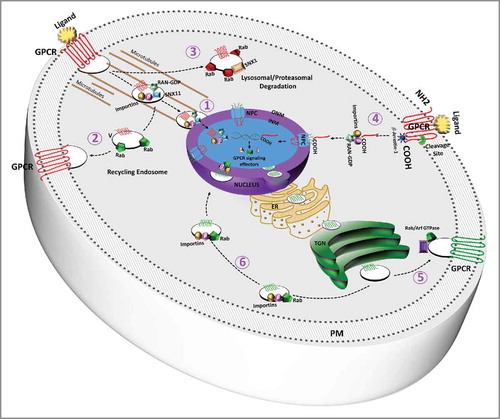Figures & data
Figure 1. Subcellular GPCR trafficking occurs via vesicular transport mechanisms which are regulated by members of Ras superfamily of small GTPases. Upon binding to its ligand at PM, 1) full-length GPCRs (e.g., F2rl1 and oxytocin receptor) can undergo agonist-induced nuclear translocation by importins and sorting nexinsCitation21,Citation22 or 2) can be recycled back by recycling Rabs (e.g., Rab 4, 11) or 3) targeted for degradation by proteasomes/lysosomes, the process regulated by Rab 7 and sorting nexin 1., 4) In case of the frizzed 2 receptor, its intracellular C-terminus is cleaved off by the action of cellular proteases and only C-terminus is then translocated to nucleus by importins and Ran GTPase.Citation69 Lastly, agonist-independent translocation of GPCRs directly from TGN 5) and 6) is controlled by rab/arf GTPases and (in case of nuclear translocation 6)) importins as well (Rab11a and importin-5 in case of the platelet-activating factor receptor).Citation36 More research is needed to understand trafficking of GPCRs between nuclear membranes and their orientation of at the NE.

Table 1. Known mechanisms and receptor motifs required for nuclear translocation of GPCRs.
